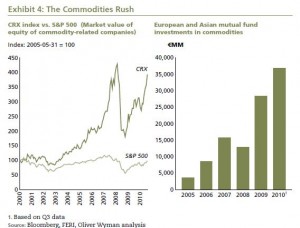The keys to any crash are the amount of leverage used to support the asset and the ability to continue borrowing.
From naked capitalism:
Yves here. While the odds of commodities-triggered 2008 style meltdown is still not the most likely outcome, recall that that pessimists like yours truly assessed the likelihood of Seriously Bad Things Happening as of early 2008 at 20-30%, which I then saw as dangerously high. In other words, tail risks are bigger than they appear.
Some of the things that favor worse outcomes than one might otherwise anticipate is investor irrationality, or what one might politely call herd behavior. For instance, a major news story today was how investors are dumping emerging markets assets willy nilly, when many are not exposed to much if any blowback from lower commodity prices and quite a few are seen as net beneficiaries. The offset is that central banks have been conditioned to break glass and overreact when banks start looking wobbly. But the Fed may be slow to get the memo, since it sees recent data (the last jobs reports and retail sales data) as strong, and is also predisposed to see its medicine as working even though it is really working only for those at the top of the food chain.
Note that this report is from Monday in Australia, and look how much oil prices have dropped since then. WTI is now at $54.28 per Bloomberg.
By David Llewellyn-Smith, founding publisher and former editor-in-chief of The Diplomat magazine, now the Asia Pacific’s leading geo-politics website. Originally posted at MacroBusiness
Regular readers will know that I’ve been keeping tabs on the Loneliest Man at Davos, the Oliver Wyman analyst that in early 2011 predicted a second round GFC triggered by a commodity crash:
John picked up the phone. It was the bank’s legal counsel, Peter Thompson, calling. He had dramatic news. Garland Brothers, one of the world’s oldest banks, would declare bankruptcy tomorrow. As he lay there in his spacious air-conditioned bedroom, unable to return to sleep, John tried to reconstruct the events of the last four years…During phase 1 we distinguish between two sources of demand affecting commodities prices: demand for use in the production of other goods (“real” demand) and demand for the purpose of price speculation (“speculative” demand). There are three major groups of players in our scenario. Firstly, there are economies, such as Latin America, Africa, Russia, Canada and Australia, which are the largest commodities producers. Secondly, there is China, which is now the world’s largest commodity importer. Thirdly, there are the developed world economies, such as the US, which are pumping liquidity into the financial system through their loose monetary policies.As with any bubble, our scenario contains a compelling narrative that allows investors to convince themselves that “this time is different”. In this case it is a story of strong economic growth coming from China creating a sustainable increase in demand for commodities.
However, it is already apparent that increasing commodities prices are also creating inflationary pressure in China, which is exacerbated by China holding its currency artificially low by effectively pegging it to the US dollar. This makes commodities look like an attractive hedge against inflation for Chinese investors. The loose monetary policy in developed markets is similarly making commodities look attractive for Western investors. This “commodities rush” is demonstrated in the right-hand chart below, which shows the asset allocations of European and Asian investors. A recent investor survey by Barclays also found that 76% of investors predicted an even bigger inflow into commodities in 2011.
Based on the currently inflated commodity prices, commodity producers in countries such as Brazil and Russia have clear business cases for investing in projects to dig more commodities out of the ground. As competition to launch such projects increases, the costs of completing them also starts to rise, with the owners of mining equipment and laborers capitalizing on the increased demand by charging higher rates. Because a portion of the demand for the projects is not coming from the real economy, an excess supply of mining capacity and commodities will be created.As with previous asset bubbles, we expect much of the debt financing for these projects to come from banks. And much of this bank financing is likely to be supplied by Western banks that are eager to preserve their diminishing return-on-equity and need to find lending opportunities that are sufficiently lucrative to cover their own increasing cost of funds. The balance sheets of life insurers will play a supporting role here, as insurers look for long-term investments that can match their liabilities and seek to earn additional illiquidity premia....MORE
